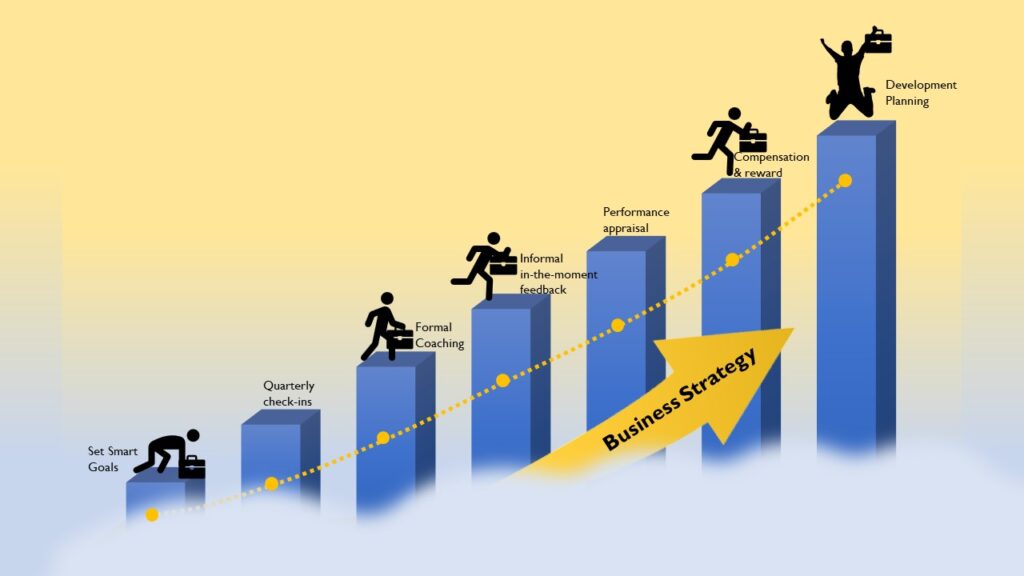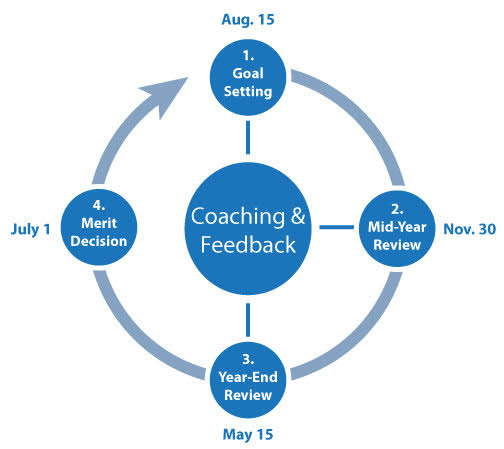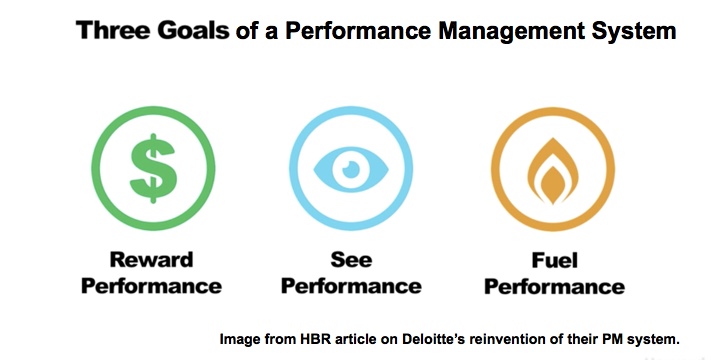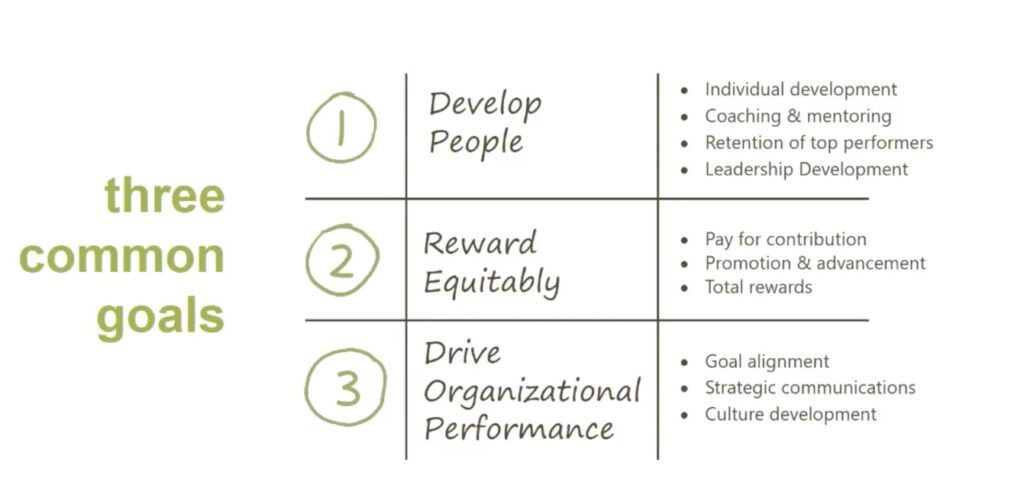SMART goals are the first step that launches the annual performance journey. They set the direction and clarify the target for the employee. Setting SMART goals puts the team member on a multi-step path toward better reward, compensation and further development. 
Goal Setting: A Fresh Perspective
2012 Oracle White paper titled Goal Setting: A Fresh Perspective
PDSA /PDCA for performance management process
C in PCDA is check. In PDSA, the S is study.
- Plan -Together with managers, employees set SMART goals, clear expectations and responsibilities
- Do – Employees do the work to meet expectations with ongoing feedback and coaching from their manager.
- Check – This is evaluation / Monitoring. — Performance appraisal.
- Act (Adjust) – Adjust and fuel performance; improve it.
The following is from Notre Dame, https://hr.nd.edu/career-development/performance-management/annual-performance-cycle/
Annual Performance Cycle and Schedule – Notre Dame
Performance Management Process
“The Performance Cycle begins in July with the mutual establishment of goals and development activities based on what is to be accomplished during the calendar year. This is the result of a discussion between the supervisor and the employee to ensure that the individual’s goals and development plan support what needs to be accomplished by the department in order to contribute to the University’s strategic initiatives and are aligned with the values and mission. These plans are then cascaded upward to be integrated with the University’s overall goals. Goal-Setting Tips

The Development Plan should be created to build the needed competencies, job skills or University Values, that were identified in the most recent performance review. Specific experiences, activities and/or learning programs should be specified as part of this plan which should be included in the same document as the planned goals.
The Mid-Year Performance Review occurs in the November timeframe which is approximately half-way into the performance year. No ratings are given at this time. The purpose is to ensure that there is an opportunity to discuss progress to date towards the goals and expectations, provide feedback regarding examples of the University Values, and determine whether any adjustments to the goals or behaviors are needed. There should be regular ongoing feedback before that point but this mid-year review helps to prevent surprises at the annual performance review.
The Year-End Review begins in the April-May timeframe with the employee’s Self-Assessment. The individual completes the review by providing examples of performance, results, and behaviors that support the rating levels the individual believes are appropriate. The manager then completes the manager sections and ratings and forwards them for the necessary review and approvals. This summary will include two separate ratings based on “What” results (Goals/Expectations) were accomplished and “How” (University Values) the work was carried out. Each separate rating will be one of four possible levels: Requires Improvement, Developing, Valued, Top. Performance Rating Categories
The Year-End Review Meeting between the employee and the supervisor is conducted and receives the employee’s final sign-off before the May 15 deadline. This discussion is intended to be a mutual discussion regarding goal accomplishment, examples of University Values and the results of the development plan activities. At the end of this discussion, there should be a mutual understanding of overall performance results and the specific actions needed for future successful performance. Conducting the Review Discussion
Performance Management Schedule
| PHASE | ACTION | EMPLOYEE DUE DATE |
|---|---|---|
| BEGIN | Plan Goals & Development for the year | September 15 |
| MID–YEAR | Review Mid-Year Progress | November 30 |
| YEAR–END | Evaluate Year-End Results |
End of notredame info.
Reinventing Performance Management at Deloitte
Read this April 2015 HBR article about Deloitte’s experience and new approach to Performance Review: https://hbr.org/2015/04/reinventing-performance-management
Watch the corresponding video: https://hbr.org/video/5122969232001/reinventing-performance-management
Deloitte has “defined three objectives at the root of performance management—to recognize, see, and fuel performance.” They have three interlocking rituals to support them—the annual compensation decision, the quarterly or per-project performance snapshot, and the weekly check-in. ”
The 3 goals of PM Process are to:
- See it. See performance–measure it right. At Deloitte, this is the performance snapshot, which serves to start the performance eval conversation and is not everything.
- Reward it. Recognize performance, particularly through variable compensation.
- Fuel it. Increase performance, not just measure it and reward it.

M. Tamra Chandler, in her book, How Performance Management Is Killing Performance—and What to Do About It, gives 3 similar goals for performance management
- Develop people
- Reward equitably (equitably doesn’t mean equally)
- Drive organizational performance

A) Three things that Deloitte’s study show correlated with performance most.
When the results were in and tallied, three items correlated best with high performance for a team:
‘“My coworkers are committed to doing quality work,”
“The mission of our company inspires me,” and
“I have the chance to use my strengths every day.”
Of these, the third was the most powerful across the organization.'”
A) Four Questions Deloitte asks team leaders after a project is completed or quarterly for long-term projects.
At Deloitte, “At the end of every project (or once every quarter for long-term projects) we will ask team leaders to respond to four future-focused statements about each team member. We’ve refined the wording of these statements through successive tests, and we know that at Deloitte they clearly highlight differences among individuals and reliably measure performance. Here are the four:
1. Given what I know of this person’s performance, and if it were my money, I would award this person the highest possible compensation increase and bonus [measures overall performance and unique value to the organization on a five-point scale from “strongly agree” to “strongly disagree”].
2. Given what I know of this person’s performance, I would always want him or her on my team [measures ability to work well with others on the same five-point scale].
3. This person is at risk for low performance [identifies problems that might harm the customer or the team on a yes-or-no basis].
4. This person is ready for promotion today [measures potential on a yes-or-no basis].” HBR article.
Deloitte asks leaders what they’d do with their team members, not what they think about them.
C) Weekly check-ins
Deloitte requires every team leader to check in with each team member once a week. The goal is to coach for near-term work instead giving feedback about past performance. It’s future focused.
“Research into the practices of the best team leaders reveals that they conduct regular check-ins with each team member about near-term work. These brief conversations allow leaders to set expectations for the upcoming week, review priorities, comment on recent work, and provide course correction, coaching, or important new information. The conversations provide clarity regarding what is expected of each team member and why, what great work looks like, and how each can do his or her best work in the upcoming days—in other words, exactly the trinity of purpose, expectations, and strengths that characterizes our best teams.”
Weekly check-ins initiated by the team member.
“Our design calls for every team leader to check in with each team member once a week. For us, these check-ins are not in addition to the work of a team leader; they are the work of a team leader. If a leader checks in less often than once a week, the team member’s priorities may become vague and aspirational, and the leader can’t be as helpful—and the conversation will shift from coaching for near-term work to giving feedback about past performance. In other words, the content of these conversations will be a direct outcome of their frequency: If you want people to talk about how to do their best work in the near future, they need to talk often. And so far we have found in our testing a direct and measurable correlation between the frequency of these conversations and the engagement of team members. Very frequent check-ins (we might say radicallyfrequent check-ins) are a team leader’s killer app.
That said, team leaders have many demands on their time. We’ve learned that the best way to ensure frequency is to have check-ins be initiated by the team member—who more often than not is eager for the guidance and attention they provide—rather than by the team leader.”
Team members take self-assessment to learn their strengths and share with team mates, team leader, and the rest of the organization.
“To support both people in these conversations, our system will allow individual members to understand and explore their strengths using a self-assessment tool and then to present those strengths to their teammates, their team leader, and the rest of the organization.”
At SD, teach people to understand their DESIGN and do spiritual-gift tests etc and share with their team members, team leader and rest of the organization. Have them take personality tests as well and share.
Miscellaneous
Performance Management vs. Performance Review
Performance Management vs. Quality Improvement
Strategic performance management
Effective performance management has to be be strategic. It needs to be build on the organizational aspirations and goals, mission. A cascade like the following.
- Organizational mission statement, goals and aspirations.
- Department mission, goals and aspirations.
- Team mission, goals and aspirations.
- Individual mission, goals and aspirations.
Mission = what you do and who you do it for.
Also, you need to have.
- Job description that is updated.
- Performance standards are clear.
- Performance management training for managers.
- Accountabilities
- Goals & Objectives
- Two way communication
- Monitoring performance
- Ongoing feedback
- Coaching
- Documentation
- Consolidate data collected throughout review period
- Gather feedback from multiple sources
- Review the organization’s review process, from time to time.
Reference / Sources to consult
2012 Oracle White paper titled Goal Setting: A Fresh Perspective

